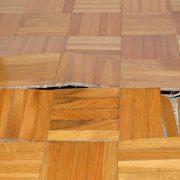Inspecting Laminate Flooring for Water Damage
Laminate flooring is most often associated with the Pergo brand of flooring and usually mimics the appearance of solid wood or engineered floors. Although laminates typically carry a 15 year warranty against discoloration and stains, they usually do not offer this type of warranty against water damage. To inspect the floor for damage caused by water, there are a number of revealing signs to look for such as crowning, and deformation or sagging.
Instructions
- Moisture meter is an invaluable tool in checking for damage due to moisture or water. If the floor boards are curled at the ends or the floor is warped or buckled, a meter can help you determine the source of the problem. For example, soil installed on concrete must be dry enough and have a humidity of less than 2.5 percent, or 1.5 percent if you have installed underfloor heating.
- Once you have determined the source of the water problem, you can take action to correct the situation. Laminate floors are installed or placed on a substrate such as vinyl or concrete. Therefore, a leak under a sink or a refrigerator or dishwasher can squeeze between the floorboards and cause the floor to swell or crown.
- Inspect the joints at the corner of the floor and make sure they are tight. Make sure that the straight joints are well aligned and fit well. Look at the socket and socket to make sure they cover the gaps. Inspect areas with gaps that have not been sealed.
- Look for mold in specific areas of the floor as that’s a clear indicator that you have a water or moisture problem. Many times this can be the result of leaking pipes or even a damp basement.
- Consider how the laminate has been maintained. If the floor has been mopped wet, water can seep through the planks and buckling may result. Make sure that the floor has been maintained as prescribed by the manufacturer.
Tips & Warnings
- Make sure you use a moisture meter to check for leaks or water leaks before installing a laminate floor.
- Install a vapor barrier or support sheet to reduce moisture for laminates installed on concrete underlayment.
- Use replaceable and dry laminate pads that are designed to attract dust and dirt. Doing so may prevent future water damage.
- Using a dehumidifier can reduce excess moisture in the air, which can cause a low deformation.
- Never mop the floor wet as excess water can cause the planks to expand and subsequently buckle. Use a damp mop if necessary and citrus-unlike soap-based cleansers to clean stains.






